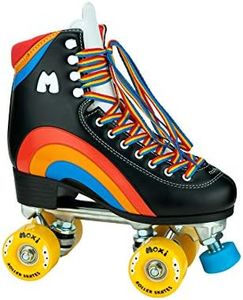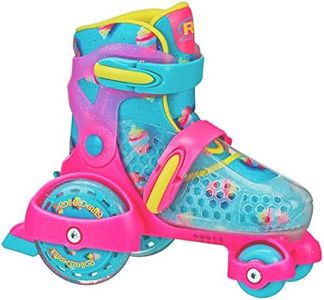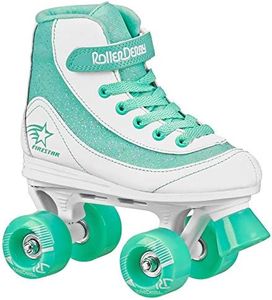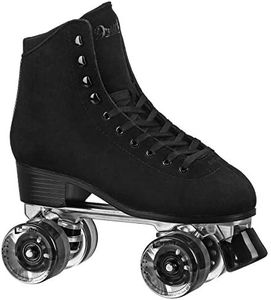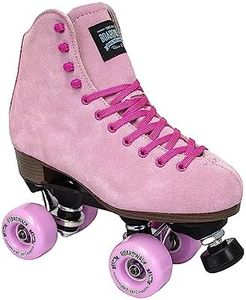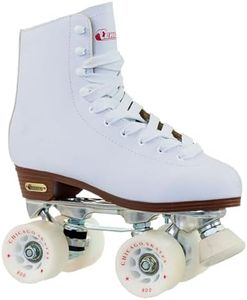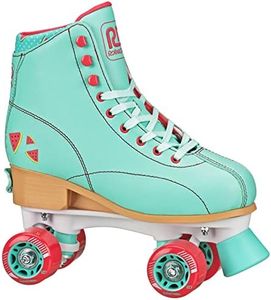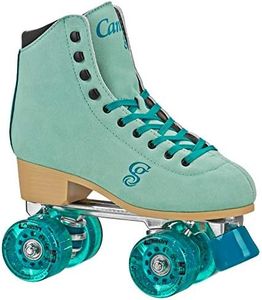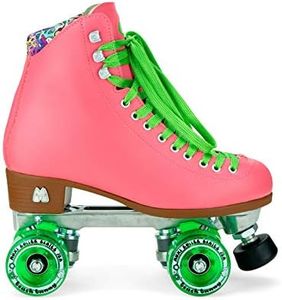We Use CookiesWe use cookies to enhance the security, performance,
functionality and for analytical and promotional activities. By continuing to browse this site you
are agreeing to our privacy policy
10 Best Roller Skates
From leading brands and best sellers available on the web.Buying Guide for the Best Roller Skates
Choosing roller skates can be a fun process, but it's important to find a pair that matches your experience, activity type, and comfort needs. Start by thinking about how you’ll use your skates: whether it's indoor or outdoor skating, fitness, dancing, or recreational skating. Understanding where and how you plan to skate will help narrow down the options and lead you to the best fit. Pay attention to key features like the boot type, wheel hardness, size, and bearing quality, as these elements greatly affect your skating experience. Always remember that personal comfort and safety come first—look for supportive fit and durable construction.Boot TypeThe boot is the part of the skate that you put your foot into, and it comes in two main styles: high-top and low-top. High-top boots offer more ankle support, making them a great option for beginners and those who want extra stability, especially when skating outdoors or learning new tricks. Low-top boots allow for more ankle movement, which can benefit people who want speed or plan to do dance and jam skating. Think about the kind of skating you’ll do most—if you need lots of ankle support go for high-tops, but if flexibility and agility matter more, low-tops are the way to go.
Wheel Hardness (Durometer)Wheel hardness is measured on a durometer scale and impacts how much grip and smoothness you get on different surfaces. Softer wheels (lower numbers, like 78A-85A) are better for outdoor skating because they absorb bumps and give you a smoother ride on rough pavement. Harder wheels (higher numbers, like 88A-101A) are favored for indoor rinks as they offer more speed and a solid grip on smooth floors. To decide, think about where you'll skate most—a softer wheel for rough outdoor terrains, or a harder wheel if you stick to polished indoor rinks.
Wheel SizeWheel size affects your speed and maneuverability. Larger wheels (about 62mm or more) roll faster and cover distances more efficiently, which is ideal for outdoor paths and long fitness skates. Smaller wheels (closer to 57-59mm) give you more control and agility, making them better for dancing, tricks, and quick direction changes. If you value speed or smoother rides on outdoor routes, opt for bigger wheels. For technical or artistic use, smaller wheels are your friend.
BearingsBearings are the small parts inside the wheels that allow them to spin freely. They’re often rated using an ABEC scale (like ABEC-3, ABEC-5, ABEC-7), which reflects their precision but doesn't tell the whole story. Higher numbers generally mean smoother and potentially faster rides, but comfort and durability matter just as much. If you’re a casual skater, you don’t need the highest ABEC rating; mid-range bearings often offer a good blend of performance and longevity. Think about how intensely and how often you plan to skate—frequent, longer sessions may benefit from higher-quality bearings.
Boot Material and PaddingBoots are made from various materials like leather, synthetic fabric, or a mix. Leather can mold to your feet over time and is very durable, ideal for those who skate often. Synthetic materials are usually lighter and require less break-in but might offer less long-term durability. Look for padding around the ankle and tongue for extra comfort. If you plan to skate for long periods or have sensitive feet, prioritize skates with good internal padding and a boot material that feels comfortable right out of the box.
Closure SystemThe way a skate closes—laces, Velcro straps, or buckles—affects fit and support. Laces provide adjustability and a snug fit but take longer to tie; straps and buckles are faster and can be easier for quick adjustments. Some skates use a combination for the best of both worlds. If you value quick entry or have difficulty tightening laces, look for more straps or buckle options, but if a custom fit is most important, traditional laces give more control.
Plate MaterialThe plate is the bottom part of the skate that connects your boot to the wheels. Plates can be made from metal (aluminum) or plastic (nylon). Metal plates are stronger and offer better power transfer, often preferred by skaters who do tricks or need extra durability. Plastic or nylon plates are lighter and less expensive, suitable for beginners or light use. Think about your skill level and intended use—if you’re planning high-impact activities, a metal plate may be better, while recreational or lighter skaters may prefer the ease of plastic.
